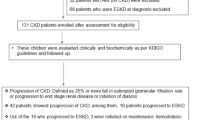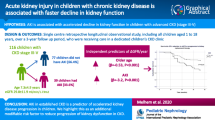Abstract
The aim of this study was to report on the clinical characteristics and outcomes of Belgian children with chronic kidney disease (CKD). Between 2001 and 2005, we followed 143 new successive patients younger than 20 years of age with a glomerular filtration rate of <60 ml/min/1.73 m2 prospectively in a Belgian department of pediatric nephrology. The incidence of diagnosed CKD was 11.9 per million child population (pmcp), and the incidence of renal replacement therapy was 6.2 pmcp. There were 67% patients in CKD stage 3, 19% in CKD stage 4 and 14% in CKD stage 5. Patients with congenital anomalies of the kidney and urinary tract (CAKUTs), hereditary diseases and glomerular diseases were diagnosed at a median age of 1, 2 and 10 years, respectively. CAKUTs were the main causes of CKD, accounting for 59% of all cases. After 3, 4 and 5 years of follow-up, 27, 31 and 38% of patients treated conservatively, respectively, reached end-stage renal failure (ESRF). The progression rate to ESRF was eightfold higher in patients with CKD stage 4 than in those with CKD stage 3. Among our patient group, hereditary diseases progressed more rapidly to ESRF than CAKUTs. Transplantation was performed preemptively in 22% of these children. Infections and cardiovascular diseases were the main causes of death.


Similar content being viewed by others
Abbreviations
- CKD:
-
Chronic kidney disease
- ESRF:
-
End-stage renal failure
- HD:
-
Hemodialysis
- PD:
-
Peritoneal dialysis
- pmcp:
-
Per million child population
- RRT:
-
Renal replacement therapy
References
Van der Heijden BJ, van Dijk PC, Verrier-Jones K, Jager KJ, Briggs JD (2004) Renal replacement therapy in children: data from 12 registries in Europe. Pediatr Nephrol 19:213–221
Schwartz GJ, Brion LP, Spitzer A (1987) The use of plasma creatinine concentration for estimating glomerular filtration rate in infants, children and adolescents. Pediatr Clin North Am 34:571–590
Bartels H, Bohmer M, Heierli C (1972) Serum creatinine determination without protein precipitation. Clin Chim Acta 37:193–197
Levey AS, Coresh J, Balk E, Kausz AT, Levin A, Steffes MW, Hogg RJ, Perrone RD, Lau J, Eknoyan G (2003) National Kidney Foundation practice guidelines for chronic kidney disease: evaluation, classification, and stratification. Ann Intern Med 139:137–147
Schröder CH, European Pediatric Peritoneal Dialysis Working Group (2003) The management of anemia in pediatric peritoneal dialysis patients. Guidelines by an ad hoc European Committee. Pediatr Nephrol 18:805–809
National High Blood Pressure Education Program Working Group on High Blood Pressure in Children and Adolescents (2004) The fourth report on the diagnosis, evaluation, and treatment of high blood pressure in children and adolescents. Pediatrics 114[Suppl 2]:555–576
Institut national de Statistique. Population par sexe et par groupe d’âge-Belgique (2000-2007). Available at: http://www.statbel.fgov.be/homefr.asp. Accessed 26 Nov 2007
Warady BA, Chadha V (2007) Chronic kidney disease in children: the global perspective. Pediatr Nephrol 22:1999–2009
Skinner R, Cole M, Pearson AD, Keir MJ, Price L, Wyllie RA, Coulthard MG, Craft AW (1994) Inaccuracy of glomerular filtration rate estimation from height/plasma creatinine ratio. Arch Dis Child 70:387–390
Ardissino G, Daccò V, Testa S, Bonaudo R, Appiani A, Taioli E, Giuseppina M, Edefonti A, Sereni F (2003) Epidemiology of chronic kidney disease in children: Data from the Italkid Project. Pediatrics 111:382–387
Miklovicova D, Cornelissen M, Cransberg K, Groothoff DL, Schroder CH (2005) Etiology and epidemiology of end-stage renal failure in Dutch children 1987-2001. Pediatr Nephrol 20:1136–1142
Deleau J, Andre JL, Briancon S, Musse JP (1994) Chronic kidney disease in children: an epidemiological survey in Lorraine (France). Pediatr Nephrol 8:472–476
Jager KJ, Zoccali C (2008) Quality of care in end-stage renal disease: the importance of comparing ‘apples with apples’. Nephrol Dial Transplant 23:1116
Tran TMH, Janssen F, Ismaili K, Khai Minh D, Vuong Kiet D, Robert A (2008) Etiology and outcome of chronic renal failure in hospitalized children in Ho Chi Minh City, Vietnam. Pediatr Nephrol 23:965–970
North American Pediatric Renal Transplant and Collaborative Studies (2006) NAPRTCS annual report. Available at https://web.emmes.com/study/ped/annlrept/annlrept2006.pdf. Accessed 24 Aug 2006
Esbjorner E, Berg U, Hansson S (1997) Epidemiology of chronic kidney disease in children: a report from Sweden 1986-1994. Pediatr Nephrol 11:438–442
Mitsnefes MM (2002) Pediatric end-stage renal disease: heart as a target. J Pediatr 141:162–164
Ismaili K, Schurmans T, Wissing M, Hall M, Van Aelst C, Janssen F (2001) Early prognostic factors of infants with chronic renal failure caused by renal dysplasia. Pediatr Nephrol 16:260–264
Acknowledgments
Presented in part at the French-speaking Society of Pediatric Nephrology (SNP), 13–15 November 2008, Nice, France. This study was supported by a grant from the Commission Universitaire pour le Développement, Projet Inter Universitaire Ciblé (CUD-PIC 2004), Belgian Ministry of Foreign Affairs, Brussels, Belgium (to Dr. Tran Thi Mong Hiep).
Author information
Authors and Affiliations
Corresponding author
Additional information
Other participants to the study were as follows: Michelle Hall, Brigitte Adams, Ksenija Lolin, Thierry Schurmans, Laure Collard, Jean-Marin Desgrottes, Pernille Hansen, An Bael, Dominique Trouet, Johan Van de Walle, Mieke Van Dyck, Jean Herman, Elena Levtchenko, Laurence Habimana, Julie Francart and Severine Henrard.
Françoise Janssen and Annie Robert share senior co-authorship.
Rights and permissions
About this article
Cite this article
Mong Hiep, T.T., Ismaili, K., Collart, F. et al. Clinical characteristics and outcomes of children with stage 3–5 chronic kidney disease. Pediatr Nephrol 25, 935–940 (2010). https://doi.org/10.1007/s00467-009-1424-2
Received:
Revised:
Accepted:
Published:
Issue Date:
DOI: https://doi.org/10.1007/s00467-009-1424-2




